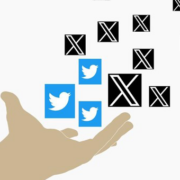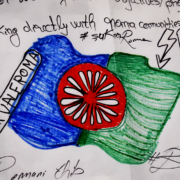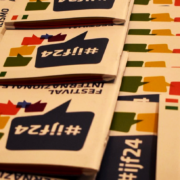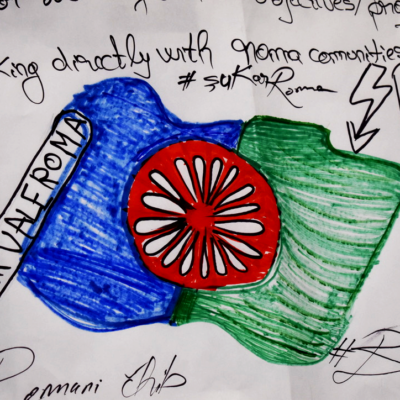“Traditional printed newspapers are dying” it is a conclusion many experts around the world agree on. The 2nd of April 2033 is predicted to become something like September 11 for the era of Gutenberg journalism. What is more frightening, printed media are vanishing together with their quality content.
Wall-E has the truth
Wall-E, the new innocent cartoon released this summer in Hollywood, is a touching story about a lonely robot that is sorting garbage on our abandoned planet in 2800. According to the plot, people left the Earth on a space cruise ship and their life there is completely serviced by robots. Human beings have nothing to do but enjoy all the time – moving on a hovering chairs, eating (actually, sucking the universal meal that combines food and drinks) and constantly watching funny stuff on their portable monitors . They are fat, behave the same and communicate with each other only virtually.
For most of Ukrainians who haven’t got their own PCs and can hardly afford themselves McDonalds meals the future of human life shown in Wall-E might seem nonsense. In more “civilized” countries, like the US or Germany, this picture is rather called realistic.
Picture-paper VS newspaper
What do you think is the largest European newspaper now? It is a German publication whose name translates as “picture” Bild.
Bild sells 3,5 million copies every day and is read by 12 million people. It is a classical tabloid with huge crying headlines, even bigger pictures and very laconic news, which often appears to be inaccurate. The editors of this tabloid believe Bild is a quality newspaper. “The unique selling proposition “that is how we define quality”, they say.
The editorial staff is also proud of providing the readers with what they want. “The idea of journalism is the same as hundreds years ago “telling people that nothing terrible or important happened to their lives today”, says Hans-Jarg Vehlewald, the chief political reporter of Bild.
Bild believes that pictures, not the text make successful newspapers. The editors explain these are images that can effectively attract the audience (95% of the circulation of Bild is sold on news-stands). Today’s front-page shows semi naked supermodel Karolina Kurkova and world boxing champion Vladimir Klitchko – the newspaper speculates on their probable love affair (these two just met each other once).
Traditional? Digital? Tradigital!
The publishing house that issues Bild, the Axel Springer Company, owns 170 more publications. And despite the fact that the whole empire is doing quite well (reported revenue in 2007 is 2,578 million Euro), its owners confess that the sales of their favorite “child” Bild are declining “just because newspapers themselves are loosing to the new high-tech mediums – Internet and cell phones.”
That is why Axel Springer is intensively developing its digital facilities. Its newspapers and magazines are available on the Internet and via mobile phones.
Axel Springer claims to build a new media era : one that combines traditional and digital media. They call it ‘tradigital’.
Axel Springer is starting to shape the audience’s mindset : digitalizing it. The readers are encouraged to get the tradigital experience. For example, for the last three years Bild has been running a citizen journalism project inviting readers to take pictures of anything scandalous they happen to see with their cell phone cameras. The best of these pictures are published in the newspaper and the authors are paid for the contributions.
Enjoy-it education
The Axel Springer Academy is a school established by the Axel Springer Company this year to bring up a new generation of journalists. The students do not study in a common academic way there, but are just playing around with two basic multimedia devices : laptops and photohandies.
“We just provide these two devices to each of our student in the beginning and let them enjoy them. We do not teach them anything”, explains the executive director of the Axel Springer Academy Rudolf Porsch.
Who would refuse to become this kind of student? Just sitting there with some cool laptop, making videos with an a-lot-of-megapixels-phonecamera and putting them together accompanied by your favorite music tracks… It does sound exciting and is just a lot easier than doing journalistic investigation!
Quality journalism: new art, science and charity?
Traditional journalism, the one that investigates tough public interest issues, that is socially oriented and that brings people to think, is dying : this is what many experts worldwide agree on. According to the Berlin-based Institute for Media and CommunicationՉ۪s recent research, quality journalism is vanishing together with its traditional medium : the printed newspaper.
Both of them are too slow and expensive for our high-tech future. According to one of the predictions, the last newspaper will be issued on April 2 2033.
Dr. Lutz Hachmeister, the director of the Institute for Media and Communication, considers that in some tens of years quality journalism will become almost an art – well-thought, well-researched stories will be produced for special orders sponsored by funds and NGOs. Few of such organizations already exist in Europe and US. The one in Germany is called ProPublica.
Some other experts are a bit more optimistic. Stefan Niggemeier, a popular German journalist and blogger, says quality journalism can survive the same way the big expensive movie industry did after cheaper TV-technology was invented. But in order to stay alive newspapers should stop trying to compete with the Internet and just be themselves. As long as possible.
By: Nadya Shkarina (Ukraine)










